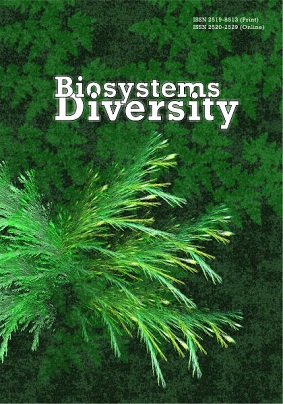Багаторічні зміни просторової структури популяцій рудої нориці (Myodes glareolus) грабової діброви
Patterns of multiannual changes in the spatial structure of a bank vole (Myodes glareolus) population in hornbeam-oak forest
Author(s): S.A. MyakushkoSubject(s): Agriculture, Energy and Environmental Studies, Sociobiology, Transformation Period (1990 - 2010), Present Times (2010 - today)
Published by: Дніпропетровський національний університет імені Олеся Гончара
Keywords: concentration; crowding; density; communities; Myodes glareolus;
Summary/Abstract: This article presents the results of research on changes in the spatial structure of a population of bank vole (Myodes glareolus Schreber, 1780) in the context of a study of multiannual dynamics of population density. The field research took place in Kaniv Nature Reserve, Cherkassy region, Ukraine, in May – June 2009–2012. In forest biotopes of the reserve the dominant mammal species is the bank vole The period of research spanned four consecutive phases of long term dynamics of density of population of this species, and also of the rodent community in general (growth – peak – decline – depression). The trapping of the animals was carried out by means of the traditional method of study plots. Parameters of spatial distribution of individuals – aggregation coefficient (K) and density of individuals within concentrations (m) – makes it possible to gain an adequate impression of the structure of populations on the basis of data on distribution of individuals within the study plots. It has been established that the spatial structure of populations of rodents naturally changes in the course of multiannual dynamics of the population. During alternation of separate phases reorganizations of the spatial distribution of bank vole populations consisted of changes in quantity and the size of concentrations, and also density of their placement. A scheme of changes in spatial structure in conditions of cyclic fluctuations of density is presented. Absence of concentration during the depression phase of dynamics is defined by the insignificant number of consumers of environmental resources, which causes a surplus and availability of these resources and is indicated also by the fact that compact distribution of animals interferes with successful realization of reproductive potential. Intensive reproduction and rapid rate of increase in a population, which are characteristic of a growth phase, cause formation and growth of separate concentrations. Increase in their area prevents rapid growth of density within these populations, and action of negative effects of overpopulation is weakened by redistribution of young animals. The phase of peak population causes merging of borders between separate concentrations and the creation of a uniform concentration with a high internal density. Later (decline phase) such concentration breaks up into a number of small concentrations which are concentrated in the most optimum habitats. We found that multiannual "pulsation" of the spatial structure of a population occurs over absolutely different time periods and is similar to the seasonal pulsation. It is possible to draw analogies between separate phases (years) of dynamics and certain seasons because at such stages the development of populations has similar patterns.
Journal: Biosystems Diversity
- Issue Year: 25/2017
- Issue No: 3
- Page Range: 169-173
- Page Count: 5
- Language: Ukrainian

